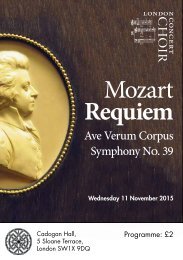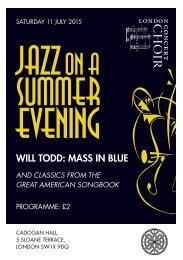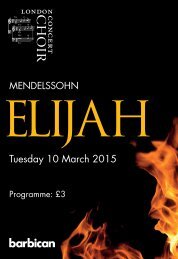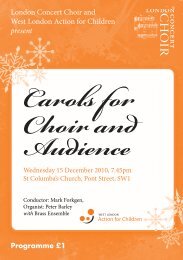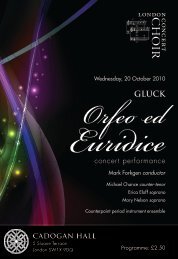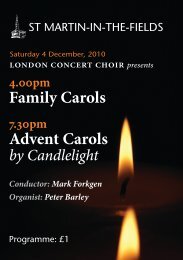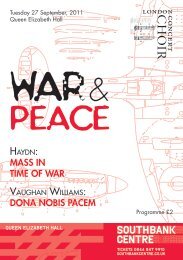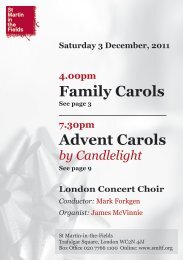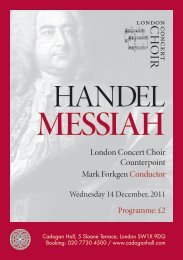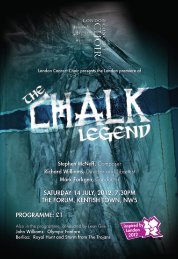10 July 2013: The French Connection
You also want an ePaper? Increase the reach of your titles
YUMPU automatically turns print PDFs into web optimized ePapers that Google loves.
THE FRENCH<br />
CONNECTION<br />
Wednesday <strong>10</strong> <strong>July</strong> <strong>2013</strong><br />
London Concert Choir<br />
Canticum<br />
Southbank Sinfonia<br />
Mark Forkgen conductor<br />
Claire Seaton soprano<br />
Duncan Rock baritone<br />
Programme: £3
Welcome to the Barbican<br />
In the interests of your comfort and safety, please note the following:<br />
• Please try to restrain coughing until the normal breaks in the performance.<br />
• If you have a mobile phone or digital watch, please ensure that it is turned off<br />
during the performance.<br />
• In accordance with the requirements of the licensing authority, sitting or<br />
standing in any gangway is not permitted.<br />
• No cameras, tape recorders, other types of recording apparatus, food or drink<br />
may be brought into the auditorium<br />
• It is illegal to record any performance unless prior arrangements have been<br />
made with the Managing Director and the concert promoter concerned.<br />
• Smoking is not permitted anywhere on Barbican premises.<br />
Barbican Centre, Silk St, London EC2Y 8DS<br />
Administration: 020 7638 4141<br />
Box Office Telephone bookings: 020 7638 8891 (9am - 8pm daily: booking fee)<br />
www.barbican.org.uk (reduced booking fee online)<br />
Programme Notes by Nancy Goodchild<br />
Programme Designed by Stephen Rickett and edited by Eleanor Cowie<br />
© London Concert Choir <strong>2013</strong><br />
London Concert Choir<br />
A company limited by guarantee, incorporated in England with registered number 3220578<br />
and registered charity number <strong>10</strong>57242<br />
Registered Office<br />
7 Ildersly Grove, Dulwich, London SE21 8EU
Wednesday <strong>10</strong> <strong>July</strong> <strong>2013</strong><br />
Barbican Hall<br />
Mark Forkgen conductor<br />
London Concert Choir, Canticum<br />
Southbank Sinfonia<br />
Claire Seaton soprano, Duncan Rock baritone<br />
Fauré: Requiem<br />
Ravel: Daphnis and Chloe, Suite No. 2<br />
INTERVAL<br />
Debussy: Prélude à l’après-midi d’un faune<br />
Poulenc: Gloria
Acknowledgements<br />
Sponsorship Scheme<br />
Earlier this year, London Concert Choir launched a new scheme for those<br />
interested in sponsoring the professional musicians in tonight’s concert.<br />
LCC would like to thank the following for their generous donations:<br />
Charles Ede Antiquities Ltd<br />
and an anonymous donor for sponsoring the Conductor<br />
Michael Shipley for sponsoring the Baritone Soloist<br />
Deborah and Andrew Cullen for sponsoring the Soprano Soloist<br />
Karen Evans for sponsoring the Leader of the Orchestra<br />
Fabyan Evans for sponsoring the Principal Double Bass<br />
Will Tilden for sponsoring the Principal Flute<br />
Tony Willson for sponsoring the Principal Percussionist<br />
Supporters’ Scheme<br />
London Concert Choir is committed to high standards and constantly strives to raise<br />
the level of its performances by means of workshops and other special events. <strong>The</strong><br />
choir is grateful for the financial contribution of its regular supporters in helping to<br />
achieve these aims, and welcomes their active involvement.<br />
Patrons and Companions of LCC<br />
Deborah Bono, Deborah Cullen, Geoffrey Deville, Karen Evans, Tim Ingram,<br />
Mark and Liza Loveday, Jennifer Powell Smith, Michael Shipley, Sybil and<br />
Nicholas Spence, Alison Stone, Anthony Willson<br />
Friends of LCC<br />
Simon Cave, Bronwen Cook, Dianne Denham, John and Judith Greenway,<br />
Jeremy Groom, Nicholas and Maureen Halton, Miriam Kramer, Anthony<br />
Smith, Ruth Steinholtz, Jill Tilden, Susan Wheatley<br />
For information on helping the choir to maintain its position as one of the leading<br />
amateur choirs in London via the Supporters’ Scheme, please email:<br />
friends@london-concert-choir.org.uk<br />
Life Friends<br />
LCC is delighted to acknowledge the invaluable contribution made by the following<br />
individuals:<br />
Peter Barley, Timothy and Patricia Barnes, Anne Clayton, Sue McFadyen,<br />
Mr and Mrs Michael Hunt, Gregory and Helen Rose, Nicholas Spence
In this evening of choral and orchestral music, impressionistic and colourful<br />
evocations of mythical landscapes and pagan sensuality are framed by<br />
two very different sacred works. <strong>The</strong> music was written by four men who<br />
all enjoyed the finer things in life, had complicated love lives and presented<br />
an elegant and urbane image to the world whilst revolutionising music<br />
in their country and establishing a style and tone of music that is<br />
quintessentially <strong>French</strong>.<br />
Requiem Mass, Op.48<br />
Gabriel Fauré<br />
for soprano and baritone soloists, choir and orchestra (1845-1924)<br />
La Madeleine was one of the newest and most prestigious churches<br />
in Paris when Fauré took up his post there as organist, choirmaster<br />
and composer in 1874. He had recently returned to civilian life after<br />
being awarded the Croix de Guerre for his bravery in the disastrous<br />
Franco-Prussian war. He now needed to rebuild his life as a musician,<br />
a career that began when an elderly blind woman heard the nine-yearold<br />
boy teaching himself to play the harmonium in her local chapel<br />
and alerted Fauré’s parents to their young son’s musical potential.<br />
Before the war, he had been forced to resign from his church post after he tried the patience<br />
of the priest once too often, failing to show the required religious conviction by turning up<br />
one morning still wearing his evening clothes from the previous night’s revelry. Perhaps<br />
also his first-hand experience of conflict separated him further from the establishment;<br />
whilst contemporaries Gounod and Franck were composing elegies and patriotic songs,<br />
Fauré instead started to produce music with a new sombre sense of tragedy and absence<br />
of fashionable operatic sentiment. In later life, he went on to confront and sweep away the<br />
conservative <strong>French</strong> musical elite and to champion students such as Maurice Ravel and<br />
Nadia Boulanger.<br />
<strong>The</strong> Requiem first began to take shape in 1887 and a short version was first performed<br />
at La Madeleine in 1888. <strong>The</strong>re were several revisions and expansions until the final,<br />
fully orchestrated version premiered at the Paris World Exhibition of 1900, and this is<br />
the version which is being performed this evening. Fauré commented later “I had been<br />
playing the organ at funeral services for so long I was completely sick of it ... I wanted<br />
to do something different” and claimed that it came about “for the sheer pleasure of it”<br />
rather than the remembrance of any one particular individual. Also, like Brahms, Fauré<br />
was very careful to select and juxtapose texts that reflected his own unorthodox view of<br />
Christian death; indeed there had to be special dispensation given for it to be played at the
composer’s own funeral. Conceptual and structural similarities between the two prompted<br />
one reviewer to suggest that Fauré’s work should be re-titled ‘A <strong>French</strong> Requiem’.<br />
During his lifetime Fauré was most famous for his songs and chamber works and his<br />
Requiem is also lightly scored and generally intimate in tone. “It is as gentle as I am myself ”,<br />
he wrote; “A happy deliverance, an aspiration towards the happiness of the hereafter rather<br />
than as a painful passing away.” <strong>The</strong> deliberate limitation and simplicity of melody in this<br />
work often seems to express a feeling of calm, fulfilled resignation. However, Fauré was<br />
celebrated not only for his love of pure melodic line and elegant harmony but also for his<br />
subtlety and complexity of effect and it is possibly too simplistic to view this piece merely<br />
as a ‘Lullaby of Death’. This Requiem is based on an intensely personal spiritual attitude.<br />
It juxtaposes darkness and light with a repeated pattern of austere chant and luminous<br />
melody which both contain many refined but evident shifts of the internalised passion<br />
which typifies much of Fauré’s work.<br />
<strong>The</strong> structure of the Requiem is organised around the central point of the soprano solo,<br />
the Pie Jesu. Everything radiates from this, which is present in the earliest sketches and<br />
forms in some sense the nucleus for the development of the whole work. On either side are<br />
placed two groups of three movements, alternating between chorus alone and chorus with<br />
baritone solo. Overall the vocal writing shows the discreet influence of Gregorian chant (to<br />
be taken up again in Maurice Duruflé’s equally beautiful Requiem of 1947).<br />
La Madeleine, Paris
1. Introit and Kyrie (choir)<br />
Fauré set the Introit and Kyrie, the opening texts of the Mass for the Dead, as a single<br />
movement. After a forte unison D in two octaves in the orchestra, the choir sings the<br />
opening text ‘Requiem aeternam’ pianissimo on a D minor chord. <strong>The</strong>re is a momentary<br />
crescendo on the words ‘et lux perpetua’. <strong>The</strong> tempo quickens as the tenors repeat<br />
the prayer for eternal rest on a simple chant; this is followed by an expressive solo ‘Te decet<br />
hymnus’ for the sopranos. <strong>The</strong> other voices join in emphatically on the words ‘Exaudi<br />
orationem meam’.<br />
In the Kyrie, the tenors’ initial theme is sung by the full chorus. <strong>The</strong> call ‘Christe eleison’<br />
is strongly accented and chromatic the first time, then repeated more softly, and the<br />
concluding ‘Kyrie eleison’ follows pianissimo.<br />
Requiem aeternam dona eis, Domine:<br />
et lux perpetua luceat eis.<br />
Te decet hymnus, Deus in Sion:<br />
et tibi redetur<br />
votum in Jerusalem.<br />
Exaudi orationem meam,<br />
ad te omnis caro veniet.<br />
Kyrie eleison.<br />
Christe eleison.<br />
Kyrie eleison.<br />
Grant them eternal rest, O Lord,<br />
and let perpetual light shine upon them.<br />
Thou art praised, O God, in Zion<br />
and unto thee shall the vow be<br />
performed in Jerusalem.<br />
Hear my prayer;<br />
unto thee shall all flesh come.<br />
Lord, have mercy.<br />
Christ, have mercy.<br />
Lord, have mercy.<br />
2. Offertory (baritone and choir)<br />
After an orchestral introduction, a duet between altos and tenors offers a simple melodic<br />
prayer ‘O Domine, Jesu Christe, Rex gloriae’ to free the souls of the departed from eternal<br />
punishment. <strong>The</strong> sequence is repeated one step higher for the next line, and again one<br />
step higher, as they are joined by the basses. <strong>The</strong> plea ‘ne cadant in obscurum’ is then sung<br />
softly and hesitantly.<br />
<strong>The</strong> baritone soloist enters with ‘Hostias et preces’ over a flowing orchestral accompaniment.<br />
Beginning on one repeated note, the solo gradually becomes more melodic and insistent<br />
at the line ‘fac eas, Domine, de morte transire ad vitam’. Finally the choir repeats the initial<br />
prayer, developing its theme in four-part harmony and concluding with a serene ‘Amen’.<br />
O Domine Jesu Christe, Rex gloriae,<br />
libera animas defunctorum<br />
de poenis inferni, et de profundo lacu.<br />
O Domine Jesu Christe, Rex gloriae,<br />
libera animas defunctorum<br />
de ore leonis,<br />
ne absorbeat tartarus.<br />
O Domine Jesu Christe, Rex gloriae,<br />
ne cadant in obscurum.<br />
O Lord Jesus Christ, King of glory,<br />
deliver the souls of the departed<br />
from the pains of hell, and from the deep pit.<br />
O Lord Jesus Christ, King of glory,<br />
deliver the souls of the departed from the<br />
lion’s mouth,<br />
that hell may not swallow them up;<br />
O Lord Jesus Christ, King of glory,<br />
may they not fall into darkness.
Hostias et preces tibi Domine<br />
laudis offerimus.<br />
Tu suscipe pro animabus illis,<br />
quarum hodie memoriam facimus.<br />
Fac eas, Domine, de morte transire<br />
ad vitam, quam olim Abrahae promisisti<br />
et semini eius.<br />
O Domine Jesu Christe, Rex gloriae,<br />
libera animas defunctorum<br />
de poenis inferni et de profundo lacu:<br />
ne cadant in obscurum. Amen.<br />
Sacrifices and prayers to <strong>The</strong>e,<br />
O Lord, we offer with praises.<br />
Receive them on behalf of those souls<br />
whom we commemorate this day.<br />
Grant them, O Lord, to pass from death<br />
into life; as once Thou didst promise<br />
to Abraham and his seed.<br />
O Lord Jesus Christ, King of glory,<br />
deliver the souls of the departed<br />
from the pains of hell and from the deep pit:<br />
may they not fall into darkness. Amen.<br />
3. Sanctus (choir)<br />
In contrast to the grandiose settings by earlier composers from the Renaissance masters<br />
to Verdi, Fauré’s Sanctus is predominantly calm and reverential. <strong>The</strong> sopranos softly sing<br />
a very simple rising and falling melody, which is repeated by the male voices. <strong>The</strong>y are<br />
accompanied by arpeggios on the harp and a violin solo derived from the soprano line<br />
‘Te decet hymnus’ in the opening movement. At the words ‘Hosanna in excelsis’ this<br />
accompaniment is replaced by firm and powerful major chords with a fanfare for horns<br />
and trumpets. <strong>The</strong> whole choir (now including the altos) sings the final ‘Sanctus’ as the<br />
harp arpeggios return, and the violin melody floats upwards to the final note.<br />
Sanctus, Sanctus, Sanctus<br />
Dominus Deus Sabaoth.<br />
Pleni sunt coeli et terra gloria tua.<br />
Hosanna in excelsis.<br />
Holy, Holy, Holy<br />
Lord God of hosts.<br />
Heaven and earth are full of Thy glory,<br />
Hosanna in the highest.<br />
4. Pie Jesu (soprano)<br />
Fauré omitted the full Dies Irae (the medieval poem depicting the fire and brimstone<br />
of the Day of Judgement) from his Requiem, with the exception of the final couplet, Pie<br />
Jesu. This is a simple and profoundly touching prayer within which he deliberately added<br />
the intensifying word ‘sempiternam’ (everlasting) to the soprano soloist’s text. In the first<br />
half of the movement, the soloist alternates with an orchestral motif which creates<br />
an echo effect.<br />
Pie Jesu, Domine, dona eis requiem,<br />
Sempiternam requiem.<br />
Merciful Jesu, grant them rest,<br />
Everlasting rest.<br />
5. Agnus Dei and Lux aeterna (choir)<br />
<strong>The</strong> tenors begin the Agnus Dei with a gently rising and falling melody in F major. <strong>The</strong><br />
other voices join them, singing with greater dynamic contrast and intensity in chords of<br />
daring harmonic progression.
<strong>The</strong> sopranos begin the following section Lux aeterna, singing the word ‘lux’ on a long<br />
light beam of sound which the choir joins with shimmering phrases, building up to an<br />
impassioned climax at ‘Cum sanctis tuis’. After a reprise by the choir of the ‘Requiem<br />
aeternam’ from the first movement, the orchestra closes with the Agnus Dei theme, this<br />
time in D major.<br />
Agnus Dei, qui tollis peccata mundi, Lamb of God, that takest away the sins<br />
dona eis requiem.<br />
of the world, grant them rest.<br />
Agnus Dei, qui tollis peccata mundi, Lamb of God, that takest away the sins<br />
dona eis requiem, sempiternam requiem. of the world, grant them rest, eternal rest.<br />
Lux aeterna luceat eis, Domine :<br />
Cum sanctis tuis in aeternum,<br />
quia pius es.<br />
Requiem aeternam dona eis, Domine,<br />
et lux perpetua luceat eis<br />
May eternal light shine upon them, O Lord,<br />
with Thy saints for ever, for Thou art merciful.<br />
Grant them eternal rest, O Lord,<br />
and let perpetual light shine upon them.<br />
6. Libera me (baritone and choir)<br />
<strong>The</strong> Libera me is a prayer for absolution which traditionally follows the Mass for the Dead.<br />
It is set apart from the other movements by its ostinato rhythms, its angular vocal writing<br />
– with leaps of an octave – its wide dynamic contrasts and its harmonic progressions. <strong>The</strong><br />
baritone soloist sings ‘Libera me ...’ then the choir continues with the anxious ‘Tremens<br />
factus sum ego’.<br />
<strong>The</strong> tempo quickens as fortissimo octaves from the horns introduce the ‘Dies illa, dies irae’<br />
– the only place where the concepts of wrath and judgement briefly appear. This quickly<br />
subsides into the calmer prayer for rest, then the whole choir, singing in unison, repeats<br />
the baritone’s opening text.<br />
Libera me Domine, de morte aeterna,<br />
in die illa tremenda:<br />
Quando coeli movendi sunt et terra:<br />
Dum veneris judicare saeculum per<br />
ignem.<br />
Tremens factus sum ego, et timeo,<br />
dum discussio venerit, atque ventura ira.<br />
Dies illa, Dies irae,<br />
calamitatis et miseriae,<br />
Dies illa, dies magna, et amara valde.<br />
Requiem aeternam dona eis, Domine,<br />
et lux perpetua luceat eis<br />
Deliver me, Lord, from eternal death,<br />
in that awful day:<br />
When the heavens and the earth shall be<br />
moved:<br />
When Thou shalt come to judge the world by<br />
fire.<br />
I tremble, and I fear the judgement and the<br />
wrath to come.<br />
That day, day of wrath,<br />
of disaster and misery,<br />
That great and exceeding bitter day.<br />
Grant them eternal rest, O Lord,<br />
and let perpetual light shine upon them.
Libera me Domine, de morte aeterna,<br />
in die illa tremenda:<br />
Quando coeli movendi sunt et terra:<br />
Dum veneris judicare saeculum per<br />
ignem.<br />
Libera me Domine, de morte aeterna.<br />
Deliver me, Lord, from eternal death,<br />
in that awful day:<br />
When the heavens and the earth shall be<br />
moved:<br />
When Thou shalt come to judge the world by<br />
fire.<br />
Deliver me, Lord, from eternal death.<br />
7. In Paradisum (choir)<br />
<strong>The</strong> choice of this additional text from the burial service shows how determined Fauré<br />
was to get away from tradition (settings of it are quite rare) and also makes clear his<br />
philosophical attitude. ‘In paradisum deducant te angeli’ is a floating melody for high<br />
sopranos, above a delicate arpeggio figure for organ. This melody is then enriched by<br />
chords from the other voices, leading towards the final ‘Jerusalem’. <strong>The</strong> sopranos invoke<br />
the choir of angels who welcomed Lazarus and the work ends as it began as all voices sing<br />
the word ‘Requiem’. <strong>The</strong> texture of this movement, together with the absolute rhythmic<br />
regularity and the long-held chords, creates a kind of weightless music outside time.<br />
In paradisum deducant te angeli:<br />
In tuo adventu suscipiant te martyres,<br />
Et perducant te<br />
in civitatem sanctam Jerusalem.<br />
Chorus angelorum te suscipiat,<br />
Et cum Lazaro quondam paupere<br />
Aeternam habeas requiem.<br />
May the angels lead you into paradise:<br />
May your arrival be greeted by the martyrs,<br />
And may they guide you<br />
into the holy city, Jerusalem.<br />
May the choir of angels receive you,<br />
And with Lazarus, who was once poor,<br />
May you have eternal rest.<br />
Théâtre du Châtelet
Daphnis and Chloe, Suite No. 2<br />
Maurice Ravel<br />
for orchestra and choir (1875-1937)<br />
At the Paris Conservatoire, Ravel was considered “self-possessed,<br />
a little aloof, intellectually biased and given to mild banter” but<br />
also described as “very gifted”. However, he failed to win sufficient<br />
prizes to launch a career as a concert pianist and returned to the<br />
Conservatoire to study composition under Fauré, to whom he<br />
became devoted. As the son of an inventor and engineer, Ravel<br />
was intensely fascinated by the different characters and capabilities<br />
of musical instruments and became admired as an orchestrator<br />
and transcriber (his orchestration of Mussorgsky’s Pictures at an<br />
Exhibition is the best-known). However, like his teacher Fauré and contemporaries such<br />
as Debussy, Ravel had to bear the disapproval and nepotism of the highly conservative<br />
<strong>French</strong> musical establishment with regard to his own compositions.<br />
In 1909, Diaghilev brought his newly formed Ballets Russes to Paris where he began to<br />
commission original works: <strong>The</strong> Firebird and Petrushka from Igor Stravinsky in 19<strong>10</strong>-11,<br />
Daphnis and Chloe from Ravel in 1912 and, most sensationally of all, <strong>The</strong> Rite of Spring<br />
from Stravinsky in 1913.<br />
Ravel’s orchestration and use of voices for Daphnis and Chloe was ambitious and demanding.<br />
He wrote to a friend “I must tell you that I have had a really insane week ... almost every<br />
night working until 3 am. ... What particularly complicates matters is that Fokine doesn’t<br />
know a word of <strong>French</strong> and I only know how to swear in Russian...” <strong>The</strong> meetings with<br />
Diaghilev and his collaborators Fokine, Bakst and Nijinsky were “chaotic” and there was<br />
constant wrangling over the ultimate artistic vision of the piece. Ravel himself was drawn<br />
less by fidelity to the historical accuracy of the Greek urns and frescoes on which Fokine<br />
wanted to base the work and much more “to the Greece of my dreams – that imagined and<br />
depicted by the late 18th-century <strong>French</strong> artists.” His frequent use of five beats to the bar<br />
drove the original dancers to distraction; in rehearsals, they took to scanning it with the<br />
impresario’s name, “Serge-Di-a-ghi-lev”.<br />
<strong>The</strong> première, given on 8 June 1912 by the Ballets Russes at the Théâtre du Châtelet,<br />
came only ten days after the production on the same stage of the company’s adaptation of<br />
Debussy’s Prélude à l’après-midi d’un faune in which Nijinsky’s erotic finale had caused a<br />
furore. <strong>The</strong>ir production of Daphnis and Chloe was not an equal success and the effort took<br />
its toll on Ravel, who became so ill towards the end of the project that he had to submit<br />
to several months of enforced rest. However, his astonishing music has justly survived<br />
in concert form. Stravinsky called it “not only Ravel’s best work but also one of the most<br />
beautiful products in all of <strong>French</strong> music”.
Design for Daphnis and Chloe: Bakst, 1912<br />
<strong>The</strong> story is taken from a pastoral romance by the third-century Greek poet Longus. In the<br />
ballet Daphnis and Chloe, abandoned as children and raised by shepherds, have fallen in<br />
love (the shepherd Daphnis charmed Chloe by playing for her on his pan-pipes). Chloe is<br />
abducted by pirates, but rescued by the god Pan and his satyrs. <strong>The</strong> second Suite comprises<br />
the whole of the third and last scene of the ballet.<br />
Lever du Jour (Daybreak): As Daphnis lies prostrate before the grotto of the nymphs, the<br />
Suite begins with one of the most magical depictions of a sunrise in all music. Woodwind<br />
arpeggios represent rivulets of dew trickling from the rocks; birdsong is heard on flutes<br />
and violins, and distant shepherds play their pipes, while a huge orchestral crescendo<br />
depicts the sunrise. <strong>The</strong> shepherds wake Daphnis to re-unite him with Chloe, and their<br />
love theme is played by unison strings, accompanied by a wordless chorus. To an oboe<br />
solo, an old shepherd explains that if Pan did save Chloe it was in memory of Syrinx, a<br />
nymph the god once loved.<br />
Pantomime: Daphnis and Chloe now re-enact the story of Pan and Syrinx. Dancing to<br />
tender and sensuous string chords and brilliant woodwind solos, Chloe impersonates<br />
the young nymph wandering in the meadow while Daphnis appears as Pan and declares<br />
his love. When his advances are rebuffed, Daphnis creates a flute from reeds and plays<br />
a melancholy tune – his complex solo is portrayed by the piccolo, flutes and alto flute.<br />
Chloe responds with an increasingly animated dance and as she finally falls into the arms<br />
of Daphnis their theme is heard in full for the last time. Solemn chords and a trumpet
melody represent the moment when Daphne pledges his love for Chloe by sacrificing at<br />
the altar of the nymphs.<br />
Danse Générale: At this point in the ballet, groups of young girls and youths invade the<br />
stage and begin a wild dance to Pan. <strong>The</strong>re are glimpses of Daphnis and Chloe’s theme in<br />
the final celebrations, as the music in quintuple time becomes ever more agitated, with<br />
whirling strings and woodwinds, insistent percussion and choral voices building up to an<br />
orgiastic frenzy or, as Ravel himself described it, “joyous tumult”.<br />
INTERVAL – 20 Minutes<br />
Prélude à l’après-midi d’un faune<br />
Claude Debussy<br />
for orchestra (1862–1918)<br />
From the outset, Debussy was considered a prodigiously<br />
talented pianist and composer but also difficult, alternately<br />
argumentative and uncommunicative and “unattractive even to<br />
his friends”. <strong>The</strong>re are several reports of his being impertinent<br />
and challenging to his tutors at the Paris Conservatoire where<br />
he studied from the tender age of ten.<br />
Although he alienated many, his formal studies culminated in<br />
winning the prestigious Prix de Rome (the same composition<br />
prize that had repeatedly eluded Ravel and led Fauré to set off on his campaign of<br />
Conservatoire reform). But Debussy did not express the expected gratitude and left Rome<br />
early, reacting against Italian opera and finding his time in the Eternal City “stifling”<br />
and “abominable”. He was to spurn eventually the giants of Russia and Germany too and<br />
assimilate instead a variety of new and exotic influences such as Javanese gamelan music<br />
(which he heard at the Paris Exposition Universelle in 1889) into his own style. He later<br />
adopted the title ‘musicien français’. He wrote “I am more and more convinced that music,<br />
by its very nature, is something that cannot be cast into a traditional and fixed form. It is<br />
made up of colours and rhythms. <strong>The</strong> rest is a lot of humbug...”<br />
Although a constant irritant for Debussy himself, it is easy to see why he was linked to his<br />
painter contemporaries, the <strong>French</strong> Impressionists – the same terminology of sensuality,<br />
fluidity of form and skilful and experimental play of light and ‘colour’ certainly applies to<br />
the comparatively early but revolutionary Prélude à l’après-midi d’un faune.<br />
<strong>The</strong> Prelude was composed in 1894, inspired by the Symbolist poet Mallarmé and originally<br />
intended to be the first of three pieces, hence the title. Debussy explained, “<strong>The</strong> music ...<br />
is a very free illustration of Mallarmé’s beautiful poem. By no means does it claim to be a<br />
synthesis of it. Rather, there is a succession of scenes through which pass the desires and
dreams of the faun in the heat of the afternoon. <strong>The</strong>n, tired of pursuing the timorous flight<br />
of nymphs and naiads, he succumbs to intoxicating sleep in which he can finally realise his<br />
dreams of possession in Universal nature.”<br />
Debussy captures the shimmering heat and eroticism of the faun’s world through a<br />
complex organisation of musical cells, with motifs carefully developed and traded between<br />
the different instruments of the orchestra.<br />
<strong>The</strong> Prelude opens, famously, with a sinuous<br />
solo flute melody that conjures up all the<br />
languor of a summer afternoon. This figure<br />
descends chromatically down an augmented<br />
fourth, or tritone (an unsettling interval<br />
that was branded ‘the devil in music’ during<br />
medieval times), before climbing back up –<br />
all the while refusing to settle in any tempo,<br />
key or tonal centre. Many aspects of Debussy’s<br />
characteristic style follow: whole-tone scale<br />
runs, brief and dexterous modulations<br />
between keys, fluid movement between<br />
different time signatures, the use of tritones<br />
in both melody and harmony, and his use of<br />
the mathematical ratio, the Golden Mean, to<br />
structure his work. And, in the first minute of<br />
the piece, Debussy mischievously throws in a<br />
bar of complete silence.<br />
Nijinsky as the Faun: Bakst, 1912<br />
Only about ten minutes in length and sparingly scored, this seemingly modest piece<br />
nevertheless signalled what Pierre Boulez considered the awakening of modern<br />
composition: “<strong>The</strong> flute of the faun brought new breath to the art of music.”<br />
Design for L‘après-midi d’un faune: Bakst
Gloria<br />
Francis Poulenc<br />
for soprano soloist, choir and orchestra (1899-1963)<br />
Unlike the previous three composers in tonight’s concert, Poulenc,<br />
who died 50 years ago, was a product of the twentieth century. Born<br />
into a chemical industrialist dynasty and inheriting his mother’s<br />
love of music, he was largely self-taught as a composer (although<br />
his early piano teacher Ricardo Viñes had championed Ravel and<br />
Debussy), and received no formal tuition in composition until he<br />
was in his early twenties.<br />
Immersing himself in the lively Parisian artistic post-WW1 scene,<br />
Poulenc came to the attention of Eric Satie and Jean Cocteau, under whose mentorship he<br />
joined a group of young radical composers known as Les Six (along with Auric, Durey,<br />
Milhaud, Tailleferre and Honegger). Taking on their decidedly anti-Romantic stance,<br />
he developed a style that combined the simplicity and clarity associated with neoclassicism,<br />
along with a dash of the self-conscious wit of the Dadaist movement and vulgarity of the<br />
Parisian music halls to which he was greatly drawn.<br />
He showed a gift for melody from his earliest work, including a large portfolio of songs, and<br />
an adherence to tonality, albeit on his own terms, that did not chime with the dissonance<br />
and deconstruction driving ‘modernism’. This meant, at first, that he was seen as the most<br />
lightweight and flippant of the group but he emerged eventually with a unique and popular<br />
style that has stood the test of time beyond that of his peers.<br />
In the 1930s Poulenc was shaken by the death of several close friends and, after a<br />
pilgrimage to the Black Madonna of Rocamadour, he re-discovered his Catholic faith<br />
and subsequently a new-found spiritual depth that tempered and complemented<br />
the ironic nature of his neoclassicism. However, like the contradiction of his ‘Parisian<br />
sexuality’ and his Catholic faith, he combined this new religious music with his old<br />
sense of fun and panache – blending influences as diverse as Gabrieli and the crooners<br />
of Paris nightclubs.<br />
Poulenc’s Gloria, commissioned by the Koussevitsky Foundation of the Library of<br />
Congress, and premiered in 1961, is a wonderful example of this blend of sacred<br />
and secular. He was censured by some for the frivolity involved in its livelier passages<br />
to which he replied “I was thinking when I composed it of those frescoes by Gozzoli<br />
with angels sticking out their tongues and of those grave Benedictines I once<br />
saw playing football.”<br />
Described by the composer as having “very clear, primary colours”, the Gloria contains<br />
echoes of the soprano arias of Verdi and the rhythms of Stravinsky; it ranges from the<br />
dramatic to the playful, yet is always sincere.
1. Gloria (choir)<br />
<strong>The</strong> first movement opens with three stately and majestic orchestral fanfares before the<br />
chorus enters, singing in an accented and declamatory manner above a busy orchestral<br />
texture. During this movement, the key modulates between G major and B minor – a<br />
relationship that returns throughout the piece.<br />
Gloria in excelsis Deo<br />
et in terra pax hominibus bonae voluntatis.<br />
Gloria.<br />
Glory be to God on high,<br />
and on earth peace to men of good will.<br />
Glory.<br />
2. Laudamus te (choir)<br />
A strange, playful instrumental introduction begins this section, which is marked ‘fast<br />
and joyous’. A light tune bounced back and forth cheekily between the voices repeats<br />
throughout this movement along with an oft-changing time signature. However, the<br />
composer interrupts this celebration briefly with a quiet and reflective passage for altos:<br />
‘Gratias agimus tibi’.<br />
Laudamus te, benedicimus te,<br />
Adoramus te, glorificamus te.<br />
Gratias agimus tibi<br />
Propter magnam gloriam tuam,<br />
Laudamus te.<br />
We praise <strong>The</strong>e, we bless <strong>The</strong>e,<br />
we worship <strong>The</strong>e, we glorify <strong>The</strong>e.<br />
We give thanks to <strong>The</strong>e<br />
for Thy great glory,<br />
We praise <strong>The</strong>e.<br />
3. Domine Deus (soprano and choir)<br />
After a tranquil woodwind introduction, this section is dominated by the dramatic solo<br />
soprano line. <strong>The</strong> chorus supplements her prayerful, fragmented and haunting melody,<br />
softly at first, then with increasing intensity and ‘impressionistic’ harmonies.<br />
Domine Deus, Rex coelestis,<br />
Deus Pater omnipotens,<br />
Domine Deus, Rex coelestis, Gloria.<br />
O Lord God, heavenly King,<br />
God the Father Almighty,<br />
O Lord God, heavenly King, Glory.<br />
4. Domine fili unigenite (choir)<br />
In this, the shortest section, the light-hearted orchestral phrases take on the joyful mood<br />
of the second movement, while the accented chorus parts are reminiscent of the first<br />
movement. <strong>The</strong> melodic lines are often pentatonic, and the quick tempo and rousing<br />
rhythms create a whirling and dancing effect.<br />
Domine Fili unigenite, Jesu Christe!<br />
Domine Deus unigenite, Jesu Christe!<br />
O Lord, the only-begotten Son, Jesu Christ!<br />
O Lord God, the only-begotten, Jesu Christ!
5. Dominus Deus, Agnus Dei (soprano and choir)<br />
<strong>The</strong> soprano soloist returns in this movement, which opens with a mysterious introduction<br />
and combines an extraordinary mixture of alternating moods – eerie and whimsical<br />
carousel, epic octaves and the intimacy of a chanson. <strong>The</strong> darker aspects are due in part<br />
to the inclusion of both an augmented fourth and an augmented fifth in the soprano’s<br />
opening melodic line.<br />
Domine Deus, Agnus Dei, Filius Patris,<br />
Rex coelestis;<br />
Qui tollis peccata mundi,<br />
miserere nobis;<br />
Qui tollis peccata mundi,<br />
suscipe deprecationem nostram.<br />
Domine Deus, Agnus Dei, Filius Patris;<br />
Qui tollis peccata mundi.<br />
O Lord God, Lamb of God, Son of the Father,<br />
heavenly King;<br />
Who takest away the sins of the world,<br />
have mercy upon us.<br />
Who takest away the sins of the world,<br />
receive our prayer.<br />
O Lord God, Lamb of God, Son of the Father;<br />
Who takest away the sins of the world.<br />
6. Qui sedes ad dexteram Patris (soprano and choir)<br />
<strong>The</strong> movement begins with a confident statement by the unaccompanied chorus, with<br />
orchestral interjections of the original fanfare theme. <strong>The</strong> main setting of the text resembles<br />
that of the first movement, with a semi-quaver line in the upper strings above a walking<br />
bass. However, Poulenc’s orchestral scoring now adds an almost glamorous sheen to the<br />
orchestral fanfares.<br />
<strong>The</strong> final section is marked in the score as extraordinairement calme. An emphatic solo<br />
‘Amen’ from the soprano is echoed by the chorus, then both reiterate the ‘Quoniam’<br />
text, but this time in a mood of rapt contemplation, accompanied by lusciously warm<br />
orchestration. <strong>The</strong>re is a farewell return of the fanfare before the music drifts peacefully<br />
to silence.<br />
Qui sedes ad dexteram Patris,<br />
miserere nobis.<br />
Quoniam tu solus Sanctus:<br />
Tu solus Dominus. Amen.<br />
Qui sedes ad dexteram Patris,<br />
miserere nobis.<br />
Quoniam tu solus Sanctus,<br />
Tu solus Dominus,<br />
Tu solus altissimus, Jesu Christe,<br />
Cum Sancto Spiritu,<br />
in gloria Dei Patris. Amen.<br />
Who sittest at the right hand of the Father,<br />
have mercy upon us.<br />
For Thou only art holy;<br />
Thou only art the Lord. Amen.<br />
Who sittest at the right hand of the Father,<br />
have mercy upon us.<br />
For Thou only art holy;<br />
Thou only art the Lord.<br />
Thou only art most high, O Jesu Christ,<br />
with the Holy Spirit,<br />
in the glory of God the Father. Amen.
Mark Forkgen – Conductor<br />
Mark Forkgen has been Music Director of London Concert Choir<br />
since 1996. He is also Music Director of Canticum chamber choir,<br />
Principal Conductor and Artistic Advisor of Kokoro, the Bournemouth<br />
Symphony Orchestra’s New Music Group, conductor of the Dorset<br />
Youth Orchestra and Director of Music at Tonbridge School. He has<br />
conducted major UK orchestras, including the Royal Philharmonic<br />
Orchestra, Orchestra of the Age of Enlightenment, Bournemouth Symphony Orchestra, City of<br />
London Sinfonia, English Chamber Orchestra, English Northern Philharmonia and Manchester<br />
Camerata, appearing at major venues, including the Royal Festival Hall, the Barbican and the<br />
Royal Albert Hall.<br />
A specialist in the field of choral and contemporary music, Mark has given the first performances<br />
of more than <strong>10</strong>0 works. He has also conducted stage works with the Trestle <strong>The</strong>atre Company<br />
and Britten Sinfonia, and contemporary opera with the Unicorn <strong>The</strong>atre Company and an<br />
ensemble from the Philharmonia, at the Linbury Studio, Royal Opera House, Covent Garden.<br />
Mark’s wide range of conducting also includes performances with Deep Purple for the Henley<br />
Festival and recreating Pink Floyd’s Atom Heart Mother in the Chelsea Festival. He has been<br />
Conductor and Artistic Advisor for highly acclaimed festivals including: Sir Peter Maxwell<br />
Davies’ 70th Birthday; Stravinsky, ‘A Festival of Britten’, ‘Music of the Americas’, ‘Britain since<br />
Britten’ and ‘East meets West’.<br />
In Europe he has conducted in Denmark (performances of Stravinsky’s <strong>The</strong> Rite of<br />
Spring), Spain, France, Belgium, Germany, Holland, Eire, the Czech Republic and Italy<br />
(including performances of Handel’s Messiah in Sienna and Israel in Egypt at the Viterbo<br />
Early Music Festival).<br />
Last season’s highlights included staged performances of Stravinsky’s <strong>The</strong> Soldier’s Tale, a major<br />
project for the Cultural Olympiad, recordings for BBC Radio 3 for ‘Music Nation’, a recital at<br />
the Royal Opera House and Sondheim’s Sweeney Todd.<br />
This season has included a production of Weill’s Threepenny Opera, a concert at the Royal<br />
Albert Hall involving 1500 performers and performances in Hong Kong and Bulgaria.
Claire Seaton – Soprano<br />
Born in Wolverhampton, Claire studied at the Birmingham School<br />
of Music, at the Royal Academy of Music with Rae Woodland and<br />
Kenneth Bowen, and subsequently with Linda Esther Gray. She joined<br />
Kent Opera during her final year at the Academy, was awarded<br />
the Wessex Glyndebourne Association Prize in 1998, and in 1999<br />
made her Glyndebourne Festival Opera debut singing the role of<br />
Vitellia in La Clemenza di Tito. Further engagements at Glyndebourne included covering the<br />
roles of Ellen Orford in Peter Grimes and the Countess in Le Nozze di Figaro, followed by<br />
contracts with Opera de Lyon and Opera Europa.<br />
One of the country’s most adaptable sopranos, Claire also enjoys remarkable success in the<br />
early music field where she has worked with ensembles such as <strong>The</strong> Tallis Scholars and the<br />
Gabrieli Consort, with whom she made her BBC Proms debut in Handel’s Dixit Dominus and is<br />
known for her performances of the soprano solos in Allegri’s Miserere.<br />
Claire’s oratorio experience is extremely broad and she is particularly renowned for her<br />
performances of Verdi’s Requiem, Brahms’ Requiem and Mozart’s C Minor Mass. Her recent<br />
repertoire has ranged from regularly performed favourites such as Verdi’s Requiem and<br />
Mozart’s Requiem to less often heard works, such as Symanowski’s Stabat Mater and Elgar’s<br />
<strong>The</strong> Light of Life.<br />
In addition to recording the Allegri, Claire’s discography includes the role of <strong>The</strong> Believer in<br />
Rutland Boughton’s Bethlehem for Naxos, Brahms’ Deutsche Requiem with Jeremy Backhouse<br />
and the Vasari Singers for Guild, and the world premiere of Jonathan Dove’s <strong>The</strong> far theatricals<br />
of day with Nicholas Cleobury. Claire has also recorded the Pergolesi Stabat Mater with the<br />
counter-tenor Andrew Watts.<br />
A recent highlight was the world premiere of Paul Mealor’s cantata <strong>The</strong> Farthest Shore with the<br />
BBC Singers, broadcast live on Radio 3 from St David’s Cathedral.
Duncan Rock – Baritone<br />
Young baritone Duncan Rock is fast making his mark on the<br />
international opera stage. He is currently a Harewood Artist for<br />
English National Opera where he recently made his Coliseum debut<br />
singing Donald in David Alden’s new production of Billy Budd. Also<br />
for ENO this season he will appear as Morales in a new version<br />
of Carmen, Schaunard in Jonathan Miller’s La Bohème, and as<br />
Papageno in the final revival of Nicholas Hytner’s much-loved <strong>The</strong> Magic Flute.<br />
As 20<strong>10</strong> Jerwood Young Artist at Glyndebourne Festival Opera, Duncan was awarded<br />
the prestigious John Christie Award. For Glyndebourne he has sung in <strong>The</strong> Rake’s Progress<br />
(designed by David Hockney), Billy Budd (directed by Michael Grandage) and the acclaimed<br />
production of L’Incoronazione di Poppea. He will return to Glyndebourne in <strong>2013</strong> for both its<br />
Festival and touring seasons.<br />
Duncan is a graduate of the National Opera Studio. He also holds a Master’s Degree in Music<br />
and Opera from the Guildhall School of Music and Drama where he received a full scholarship<br />
from the Independent Opera foundation.<br />
As winner of the 2006 Australian Singing Competition, Duncan was presented with the<br />
Marianne Mathy Award by the late Dame Joan Sutherland. He has since been a Samling<br />
Scholar, Royal Philharmonic Society Young Artist, a finalist in the Kathleen Ferrier Competition<br />
and the recipient of the Overseas Award from the Royal Overseas League Singing Competition.<br />
He was awarded the song prize and overall second place at the 2009 Mozart International<br />
Singing Competition. That same year he took master classes at the Mozarteum Academy<br />
Salzburg and was a Steans Institute Young Artist at the Ravinia Festival in Chicago. He also<br />
sang for a television audience of millions during the Ashes opening ceremony in Cardiff.<br />
Duncan has performed at the Royal National <strong>The</strong>atre and for the Queen at Australia House;<br />
sung Rachmaninov songs at the Barbican Centre with the London Symphony Orchestra and<br />
the bass lead in Handel’s Messiah at the Royal Albert Hall conducted by Sir David Willcocks.<br />
He is privileged to have worked with some of the world’s leading musicians and performers,<br />
including Sir Mark Elder, Sir Charles Mackerras, Vladimir Yurovsky, Sir Thomas Allen, Edward<br />
Gardiner, Dmitri Hvorostovsky, Malcolm Martineau, Graham Johnson, Iain Burnside and<br />
Valery Gergiev. Future engagements include debuts in major roles for Frankfurt Opera, Opera<br />
North and Boston Lyric Opera.
London Concert Choir<br />
London Concert Choir, founded as the Brompton Choral Society<br />
in 1960, now has around 150 members of a wide range of ages<br />
and is notable for its unusually broad musical repertoire. With<br />
Music Director Mark Forkgen the choir regularly appears at all<br />
the major London concert venues, including the Southbank Centre<br />
and Cadogan Hall as well as the Barbican, and in cathedrals and<br />
churches in and around the capital.<br />
<strong>The</strong> choir also tours to European destinations. In 2011 a<br />
performance of Verdi’s Requiem with the Augsburg Basilica Choir<br />
in the Royal Festival Hall was followed by a joint concert at the<br />
Augsburg Peace Festival. LCC celebrated its 50th anniversary in<br />
20<strong>10</strong> with two performances of Britten’s War Requiem – at the<br />
Barbican with Southbank Sinfonia and in Salisbury Cathedral<br />
with Dorset Youth Orchestra. Performances of other large-scale<br />
works have included Beethoven’s Missa Solemnis with the English<br />
Chamber Orchestra, Vaughan Williams’ Sea Symphony with the<br />
Royal Philharmonic Orchestra and Verdi’s Requiem and Elgar’s<br />
Dream of Gerontius with Southbank Sinfonia.<br />
On a smaller scale, LCC has sung rarely-heard settings of<br />
the Russian Orthodox liturgy by Gretchaninov, Tchaikovsky<br />
and Rachmaninov and recently gave a concert of music from<br />
the Queen’s Coronation. <strong>The</strong> choir’s performances with the<br />
Counterpoint period instrumental ensemble include Handel’s<br />
Messiah, Bach’s St Matthew Passion, Haydn’s oratorio <strong>The</strong><br />
Creation and the London premiere of a reconstruction of Mozart’s<br />
C minor Mass.<br />
In <strong>July</strong> 2012 LCC was joined by the Kokoro ensemble, youth<br />
orchestras and choirs from local schools for the London premiere<br />
of Stephen McNeff’s opera-oratorio <strong>The</strong> Chalk Legend. Concert<br />
performances of operas and musicals have included Gluck’s<br />
Orfeo, Purcell’s Dido and Aeneas, Gershwin’s Porgy and Bess and<br />
Lerner and Loewe’s My Fair Lady. <strong>The</strong> choir often gives concerts<br />
for charity and has commissioned a number of new works.<br />
Mark Forkgen<br />
Music Director<br />
James Longford<br />
Principal Accompanist<br />
Fabyan Evans<br />
Chairman<br />
Will Tilden<br />
Concert Manager<br />
Barbara Whent<br />
Treasurer<br />
Stephen Rickett<br />
Design and<br />
Communications<br />
Jennifer Greenway<br />
Membership<br />
Eleanor Cowie<br />
Publicity<br />
Tim Thirlway<br />
Assistant Concert<br />
Manager<br />
Simon Livesey<br />
Company Secretary<br />
www.london-concert-choir.org.uk
Canticum<br />
Mark Forkgen – Music Director<br />
Canticum is one of the most musically versatile chamber choirs in the country. Now in<br />
its 23rd season, it is praised for accomplished performances of major works and for<br />
exploring contemporary repertoire. <strong>The</strong> choir has also commissioned new writing and gives<br />
regular first performances.<br />
This season’s concerts have included Tchaikovsky’s Sacred Pieces and Gretchaninov’s Vespers<br />
at the Greek Orthodox Cathedral in London, and a concert to a packed house at St Martin-inthe-Fields<br />
featuring Mozart’s C Minor Mass. Other highlights include BBC Radio 4’s Christmas<br />
Morning Service, Bach’s Mass in B Minor with the Orchestra of <strong>The</strong> Age of Enlightenment at<br />
St John’s, Smith Square, and the première of Sir Peter Maxwell Davies’s Step by Circle, dedicated<br />
to Mark Forkgen and the choir. By way of contrast, the choir opened the 2008 Chelsea Festival,<br />
providing choral voices for Pink Floyd’s Atom Heart Mother alongside soloist David Gilmour.<br />
Canticum regularly tours overseas and has just returned from a successful trip to Bulgaria.<br />
Performing a varied programme of European music, the choir supported the British<br />
Embassy’s ‘British weeks’ programme. Previous tour highlights include Purcell’s Dido and<br />
Aeneas, and Handel’s Messiah and Israel in Egypt, a performance which opened the Viterbo<br />
Early Music Festival.<br />
Recording, too, has an important place in Canticum’s schedule. <strong>The</strong> existing catalogue includes<br />
A Hymn to the Virgin, with works by Victoria, Poulenc and Panufnik, and In the Gloom of<br />
Whiteness, featuring work by Colin Riley, Fraser Trainer and Keith Roberts. <strong>The</strong> live recording of<br />
Sir Peter Maxwell Davies’s Step by Circle and Two Latin Motets is also available. Two Christmas<br />
albums, A Christmas Carol, recorded in aid of the Samaritans, and <strong>The</strong> Christmas Story<br />
complete the current recording library.<br />
www.canticum.org.uk
Southbank Sinfonia<br />
Southbank Sinfonia is an orchestra of young professionals<br />
described by <strong>The</strong> Times as ‘a dashing ensemble who play with<br />
exhilarating fizz, exactness and stamina’. Now celebrating<br />
its tenth anniversary, Southbank Sinfonia is internationally<br />
recognised as a leading orchestral academy, providing<br />
graduate musicians from all over the world with a muchneeded<br />
springboard into the profession.<br />
Every year its players, each supported by a bursary, undertake<br />
an intensive and wide-ranging nine month programme<br />
of performance and professional development. This<br />
comprises performances across Britain and Europe involving<br />
orchestral repertoire, chamber music, opera, dance<br />
and theatre, alongside development sessions embracing<br />
leadership and teamwork, and opportunities to be rolemodels,<br />
inspiring many younger musicians on London’s<br />
Southbank and beyond.<br />
A distinctive and integral part of the programme is the<br />
orchestra’s creative partnerships with leading performing<br />
arts organisations including the Royal Opera, National<br />
<strong>The</strong>atre, BBC Concert Orchestra, Academy of St Martin-inthe-Fields,<br />
and acclaimed artists such as Patron Vladimir<br />
Ashkenazy. <strong>The</strong> orchestra is proud to be based at St John’s<br />
Waterloo, in the heart of London, where its regular free Rush<br />
Hour concerts give many people their first ever experience of<br />
live orchestral music.<br />
Southbank Sinfonia receives no public funding and is indebted<br />
to its many individual donors, trusts and foundations, and<br />
corporate supporters who believe in the potential of its young<br />
musicians. If you are inspired by what you hear tonight,<br />
you too can make a difference to the journey these young<br />
artists will take this year. To find out how you can support<br />
the orchestra and discover more about its next exciting<br />
performances, visit the website:<br />
Sean Finnan<br />
Chairman<br />
Simon Over<br />
Music Director<br />
James Murphy<br />
Managing Director<br />
Jan Smith<br />
Finance & Administration<br />
Director<br />
Sarah Tattersall<br />
Development Director<br />
Ellie Geller<br />
Orchestra Manager<br />
Joanna Perry<br />
Orchestra Assistant/<br />
Music Librarian<br />
Jennifer Lang<br />
Creative Leadership<br />
Manager<br />
Hannah Horsburgh<br />
Projects Manager<br />
Jane Ainger<br />
Trusts & Foundations Manager<br />
Charlotte Castle<br />
Development Manager<br />
Katharine Verney<br />
Partnerships Advisor<br />
Harriet Mayhew<br />
Marketing Manager<br />
David Corkhill<br />
Assistant Conductor<br />
Eugene Lee<br />
Associate Leader<br />
www.southbanksinfonia.co.uk
Members of London Concert Choir<br />
Soprano<br />
Hannah Baker<br />
Gillian Bibby<br />
Dagmar Binsted<br />
Mickey Bowden<br />
Sarah Burr<br />
Jane Cameron<br />
Alison Carpenter<br />
Eleanor Cowie<br />
Sally Davis<br />
Gillian Denham<br />
Susan Deville<br />
Nicola Dixon-Brown<br />
Emily Dresner<br />
Serena Ede<br />
Erika Emerson<br />
Sarah <strong>French</strong><br />
Lisa Gardner<br />
Jennifer Greenway<br />
Jennifer Hadley<br />
Ruth Hobbs<br />
Laura Holland<br />
Christine Ingram<br />
Anna Isworth<br />
Lisa Jansson<br />
Jane Joyce<br />
Vickie Kelly<br />
Anna Kosicka<br />
Frances Lake<br />
Tracy LeBrun<br />
Susanna Lutman<br />
Nadine Martin<br />
Jessica Metcalfe<br />
Stephanie Moussadis<br />
Carolyn Newman<br />
Fiona Paterson<br />
Sophie Pownall<br />
Jutta Raftery<br />
Arianna Rondos<br />
Ella Salter<br />
Rachel Scanlon<br />
Frances Shaw<br />
Caroline Sheppard<br />
Philippa Stroud<br />
Amy Thomas<br />
Teresa Tilden<br />
Natalie Tompkins<br />
Francesca Walsh<br />
Janet Wells<br />
Julie Wilson<br />
Alto<br />
Helen Beddall-Smith<br />
Frances Cave<br />
Lucy Charman<br />
Carys Cooper<br />
Deborah Curle<br />
Georgie Day<br />
Kathleen Dormer<br />
Venetia Ellvers<br />
Rebecca Foulkes<br />
Claire Garbett<br />
Anna Garnier<br />
Mary Glanville<br />
Muriel Hall<br />
Penny Hatfield<br />
Joan Herbert<br />
Tina Holderried<br />
Caroline Holloway<br />
Chrina Jarvis<br />
Chris Joseph<br />
Sabine Koellmann<br />
Joanna Kramer<br />
Meghana Kumar<br />
Helene Labit<br />
Lorna Lewis<br />
Norma MacMillan<br />
Bridget Maidment<br />
Sara Marr-Phillips<br />
Anna Metcalf<br />
Sophy Miles<br />
Judith Paterson<br />
Rachel Pearson<br />
Gillian Perry<br />
Katja Pluto<br />
Dubravka Polic<br />
Katie Prior<br />
Pippa Ranger<br />
Caroline Rawlence<br />
Agnes Ringa<br />
Mary Ann Sieghart<br />
Tabitha Strydom<br />
Kate Tranter<br />
Rachel Vroom<br />
Gabriel West<br />
Barbara Whent<br />
Jane Whittaker<br />
Belinda Whittingham<br />
June Williams<br />
Nathalie Wilson<br />
Tenor<br />
Charles Black*<br />
Andrew Bolan<br />
Christopher Boustred<br />
David Broad<br />
Roy Carryer<br />
Mark Cheesman<br />
Dave Dosoruth<br />
James Ede<br />
Fabyan Evans<br />
John Galt<br />
Nicholas Hall<br />
Sam Hansford<br />
Richard Holmes<br />
David Ireland<br />
Ben Jones*<br />
Carolyn Knight<br />
Eli Konvitz<br />
Ian Leslie<br />
Ben Martin<br />
William Osman*<br />
Stephen Rickett<br />
Tim Steer<br />
Tim Thirlway<br />
Bass<br />
Colin Allies<br />
Peter Banks<br />
Ed Brown<br />
Richard Burbury<br />
Jim Cameron<br />
Henry Cook<br />
Bill Cook<br />
Andrew Cullen<br />
Albert Edwards<br />
James Finlay<br />
Richard Gillard<br />
Nigel Grieve<br />
James Grimwood*<br />
Nigel Hartnell<br />
Graham Hick<br />
Ian Judson<br />
Robert Kealey<br />
Stephen Kingston<br />
Stefan Klaazen<br />
Ben van Leeuwen*<br />
James Littleton*<br />
Simon Livesey<br />
Barnaby Lynch*<br />
Angus Macdonald<br />
Alan Machacek<br />
Ian Mackintosh<br />
Christopher<br />
Powell-Smith<br />
Dai Prichard<br />
Simon Retallack<br />
Morgan Roberts<br />
Anthony Sharp<br />
Ryszard Stepaniuk<br />
William Tilden<br />
Tony Trowles<br />
Dai Whittingham<br />
*Tonbridge School
Members of Canticum<br />
Soprano<br />
Polly Elder<br />
Mary Forkgen<br />
Janet Hales<br />
Francesca Harden<br />
Alison Kennedy<br />
Ruth Knowles<br />
Angela Parry<br />
Susan Porter Thomas<br />
Anna Power<br />
Emily Roberts<br />
Sarah Sammons<br />
Elizabeth Scott Plummer<br />
Hannah Shield<br />
Alto<br />
Hannah Emmanuel<br />
Nancy Goodchild<br />
Sophie Marris<br />
Hilary Norman<br />
Ally Stewart<br />
Jan Trott<br />
Tenor<br />
Edward Allen<br />
Richard Houston<br />
Richard O’Neill<br />
Nick Pyke<br />
Matthew Ralph<br />
Mark Stedman<br />
Philip Wilson<br />
Bass<br />
Edward Davison<br />
Michael King<br />
David Knowles<br />
Rod McPhee<br />
Mike Pelmore<br />
James Pepler<br />
Simon Scott Plummer<br />
Gordon Taylor<br />
Philip Towler
Southbank Sinfonia<br />
Violin I<br />
Eugene Lee<br />
Matthew Bethel<br />
Eva Petrarca<br />
Tzu-Fan Tang<br />
Zanete Uskane<br />
Eva Demeter<br />
Charlotte Maclet<br />
Alberto Vidal Borella<br />
Susie Watson<br />
Mark Lee<br />
Rebecca Matthews<br />
Edward McCullagh<br />
Violin II<br />
Julia Loucks<br />
Alessandro Cannizzaro<br />
Hao Zhou<br />
Pierre Largeron<br />
Maria Ryan<br />
Elspeth MacLeod<br />
Gaëlle-Anne Michel<br />
Seila Tammisola<br />
Willemijn Steenbakkers<br />
Nicole Stokes<br />
Viola<br />
Joseph Fisher<br />
Jennifer Coombes<br />
Tegen McGrahan<br />
Maria Niedbala<br />
Ben Harrison<br />
Liam Buckley<br />
Kimberly Harrenstein<br />
Barnaby Adams<br />
Cello<br />
Angélique Lihou<br />
Davina Shum<br />
Alice Murray<br />
Nathan Harrenstein<br />
Arthur Boutillier<br />
Alba Acevedo<br />
Bass<br />
Laura Murphy<br />
David Johnson<br />
Lachlan Radford<br />
Mark Lipski<br />
Seb Pennar<br />
Rodrigo Moro Martin<br />
Harp<br />
Daniel De Fry<br />
Fontaine Liang<br />
Organ/Celeste<br />
James Longford<br />
Flute<br />
Luke Russell<br />
Mathilde Caldérini<br />
Sarah Bennington<br />
Gareth McLearnon<br />
Oboe<br />
Amy Turner<br />
Anna Turmeau<br />
Vanessa Howells<br />
Clarinet<br />
Rocio Bolanos<br />
Kimon Parry<br />
John Slack<br />
William Duncombe<br />
Bassoon<br />
Christina Marroni<br />
Susanne Simma<br />
Sophie Crawford<br />
Ruth Rosales<br />
Horn<br />
Charles Hutchinson<br />
Laetitia Stott<br />
Hannes Arnold<br />
Chris Beagles<br />
Trumpet<br />
Jonny Abraham<br />
David Marley<br />
Oliver Carey<br />
Russell Jackson<br />
Trombone<br />
William Yates<br />
Iain Maxwell<br />
Ross Brennan<br />
Tuba<br />
Mark Probert<br />
Timpani/Percussion<br />
James Bower<br />
Tim Brigden<br />
Catherine Ring<br />
Ben Fullbrook<br />
Ben Lewis<br />
Ross Garrod<br />
Michael Rareshide<br />
Bex Burch<br />
Sarah Stuart
Future Concerts<br />
Tuesday 22 October, <strong>2013</strong>, 7.30pm<br />
St. Sepulchre-without-Newgate Church,<br />
Holborn Viaduct, London EC1<br />
Victoria: Missa Salve Regina<br />
Rossini: Petite Messe Solennelle<br />
Tuesday 17 December, <strong>2013</strong>, 7.30pm<br />
Cadogan Hall, Sloane Terrace, SW1<br />
Bach: Christmas Oratorio - Parts 1, 2 and 3<br />
Mailing List<br />
If you would like to receive advance information about our concerts, you can join the<br />
choir’s free mailing list by emailing:<br />
mailinglist@london-concert-choir.org.uk<br />
<strong>The</strong> information you provide is subject to the Data Protection Act and as such will be<br />
used exclusively by London Concert Choir.<br />
Joining the Choir<br />
London Concert Choir welcomes new members, who are invited to attend a few<br />
rehearsals before an informal audition. If you are interested in joining the choir,<br />
please fill in your details online at:
www.london-concert-choir.org.uk/joinus<br />
Charles Ede Ltd<br />
Classical Antiquities<br />
www.charlesede.com<br />
Bust of the Aphrodite of Epidaurus<br />
c.1st century AD to early 2nd century AD. 20” (50cms)




